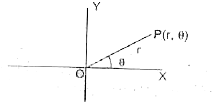A line OA length r starts from its initial position OX and traces an angle AOB=α in the anticlockwise direction. It then traces back in the clockwise direction an angle BOC=3θ ( where α>3θ ) . L is the foot of the the perpendicular from C on OA. sin3θCL=cos3θOL=1
1−rcosαrsinα is equal to Solution in Telugu
sinα
cosα
sinθ
cosθ
The correct Answer is:B
Step by step video, text & image solution for A line OA length r starts from its initial position OX and traces an angle AOB = alpha in the anticlockwise direction. It then traces back in the clockwise direction an angle BOC = 3 theta ( where alpha gt 3 theta ) . L is the foot of the the perpendicular from C on OA. (sin^3 theta)/(CL) = (cos^3 theta)/(OL ) = 1 (1- r cos alpha)/(r sin alpha) is equal to by Maths experts to help you in doubts & scoring excellent marks in Class 11 exams.
Topper's Solved these Questions
- BOOK - AAKASH SERIESCHAPTER - MULTIPLE & SUBMULTIPLE EXERCISE - LECTURE SHEET (EXERCISE - I) (Straight Objective Type Questions)16videos
MULTIPLE & SUBMULTIPLE
- BOOK - AAKASH SERIESCHAPTER - MULTIPLE & SUBMULTIPLE EXERCISE - LECTURE SHEET (EXERCISE - I) (Integer Type Questions)6videos
MULTIPLE & SUBMULTIPLE
- BOOK - AAKASH SERIESCHAPTER - MULTIPLE & SUBMULTIPLE EXERCISE - LECTURE SHEET (EXERCISE - I) (More than One correct answer Type Questions)8videos
MULTIPLE & SUBMULTIPLE
- BOOK - AAKASH SERIESCHAPTER - MEAN VALUE THEOREMSEXERCISE - PRACTICE SHEET (EXERCISE-I (LEVEL-II (MORE THAN ONE CORRECT ANSWER TYPE QUESTIONS ) )2videos
MEAN VALUE THEOREMS
- BOOK - AAKASH SERIESCHAPTER - MULTIPLE & SUBMULTIPLE ANGLESEXERCISE - PRACTICE EXERCISE68videos
MULTIPLE & SUBMULTIPLE ANGLES
Similar Questions
tan9∘−tan27∘−tan63∘+tan81∘ =
01:31View SolutionIf 4sin27∘=√α+√β then the sum of the digits in (α+β+αβ+2)4
02:31View SolutionIf (x−a)cosθ+ysinθ=(x−a)cosϕ+ysinϕ=aandtan(ϕ/2)=2b then
02:12View SolutionGiven f(x) = 4- ((1)/(2) - x)^(2//3) , g(x) = {:{((tan[x])/(x),","x cancel(=)0),(1,","x=0):}" "h(x)={x}, k (x) = 5^(log_(2)(x+3))
Then in [0,1], Lagrange's mean value theorem is not applicable to (where [.] and {.} represents the greatest integer functions and fractions part functions, respectively )04:21View Solution(sinA1−cosA)−(1−cosAsinA)=
06:56View SolutionIf sin alpha=(1)/(2) and cos theta=(1)/(3) then the values of alpha+theta( if theta,alpha are both acute angles) will lie in the interval
07:04View Solutionsin(3 theta+alpha)+sin(3 theta-alpha)+sin(alpha-theta)-sin(alpha+theta)=cos alpha
View SolutionA line OA of length r starts from its initial position OX and traces an angle AOB = α in the anitclockwise direction. It then traces back in the clockwise direction an angle BOC = 3θ ( where α>3θ). L is the foot of the perpendicular from C on OA. Also, sin3θCL=cos3θOL=1
1−rcosαrsinα is equal to05:52View SolutionA line OA of length r starts from its initial position OX and traces an angle AOB = α in the anitclockwise direction. It then traces back in the clockwise direction an angle BOC = 3θ ( where α>3θ). L is the foot of the perpendicular from C on OA. Also, sin3θCL=cos3θOL=1
2rsinα1+2rcosα is equal to03:57View SolutionA line OA of length r starts from its initial position OX and traces an angle AOB = α in the anitclockwise direction. It then traces back in the clockwise direction an angle BOC = 3θ ( where α>3θ). L is the foot of the perpendicular from C on OA. Also, sin3θCL=cos3θOL=1
2r2−1r is equal to13:05View SolutionIf cos(θ−α),cos(θ),Cos(θ+α) are in H.P. and cosα≠1, then angle α lie in the
View SolutionLet OP=rand∠XOP=θ then the position of P in polar coordinate system is represented by (r,θ) OX and O are called the initial line and pole respectively.
If p be the length of perpendicular from origin to line and if α is the angle which the perpendicular to the line makes with the initial line . The equation of line is given by r cos (θ−α)=p

Perpendicular distance from pole to the line lr=4cosθ+2sinθ isView SolutionA line OA of length r starts from its initial position OX and traces an angle AOB = α in the anitclockwise direction. It then traces back in the clockwise direction an angle BOC = 3θ ( where α>3θ). L is the foot of the perpendicular from C on OA. Also, sin3θCL=cos3θOL=1
2rsinα1+2rcosα is equal toView SolutionA line OA of length r starts from its initial position OX and traces an angle AOB = α in the anitclockwise direction. It then traces back in the clockwise direction an angle BOC = 3θ ( where α>3θ). L is the foot of the perpendicular from C on OA. Also, sin3θCL=cos3θOL=1
2r2−1r is equal toView SolutionA line OA length r starts from its initial position OX and traces an angle AOB=α in the anticlockwise direction. It then traces back in the clockwise direction an angle BOC=3θ ( where α>3θ ) . L is the foot of the the perpendicular from C on OA. sin3θCL=cos3θOL=1
1−rcosαrsinα is equal toView Solution
